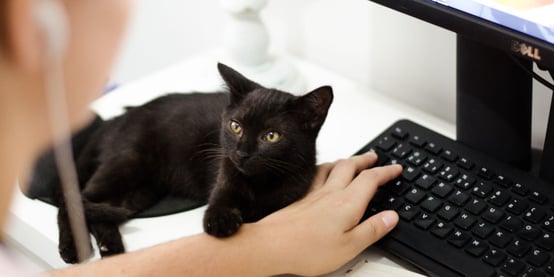Thinking of getting pet insurance? If so, you’ve likely done some research into existing pet insurance providers and policies. Finding the right plan for you and your pet is an important decision and requires knowing the facts to make the best choice.
Our goal is to help pet owners know what to look for when comparing pet insurance providers and plans. From the amount of coverage to monthly deductibles to exclusions, it’s essential that you have the information you need to find the right solution for your pet.
Read on for everything you need to know about pet insurance, plus the right questions to ask when searching for an amazing pet insurance provider!
Everything You Need to Know About Pet Insurance
.png?width=751&height=376&name=10%20questions%20to%20ask%202%20(1).png)
Photo by Alvan Nee on Unsplash
There are some essential questions to ask when considering different pet insurance providers.
Not every provider will have this information readily available, so it’s important to ask these questions before signing up for a plan. Answers to these questions will provide everything you need to know about selecting the right policy. Keep in mind that this list may not be all-inclusive, but it will cover the most important questions when choosing pet insurance for your furry companion.
1. What does the insurance policy cover?
Perhaps the most important question pertains to the extent of your coverage and what expenses will be reimbursed. This makes up the bulk of your plan, and will likely be the information you refer to most often when seeking reimbursement for a vet visit.
You’ll want to know whether routine care, accidents, illnesses, and other conditions are covered under the policy. The degree of coverage you sign up for should align with your pet’s current health and wellness goals.
For example, a younger pet may require initial vaccinations, flea and tick preventative regimes, etc. For older pets, you might anticipate more future illnesses or serious medical conditions. Understanding the extent of coverage ensures you're aware of what expenses will be reimbursed.
When searching for a plan, look for comprehensive coverage that includes a wide range of covered conditions and treatments relevant to your pet's needs.
2. Are there any breed-specific exclusions or limitations?
It’s important to note that some insurance providers exclude certain breeds or impose limitations due to breed-specific health issues.
For example, brachycephalic dog breeds such as Bulldogs, Pugs, and French Bulldogs are known for their distinctive flat faces and are prone to various health issues such as respiratory problems, eye conditions, and skin fold infections. Insurance providers may exclude these breeds due to the increased likelihood of medical expenses associated with their unique health challenges.
So, if you have a breed that’s prone to specific health conditions, knowing about any exclusions or limitations can help you plan for potential healthcare costs. That way, you can rule out providers that have these exclusions or subject you to significantly higher premium costs.
3. What is the reimbursement process like?
You’ll also want to know what the pet insurance provider’s reimbursement process looks like. Not only will this set expectations for how you will receive reimbursement, but also help you navigate filing claims efficiently.
Typically, pet insurance reimbursement involves you (the pet owner) paying the full veterinary bill upfront, then submitting a claim that includes an itemized invoice and medical records to the insurance provider. Once the claim is processed and approved, the insurer reimburses you for eligible expenses, usually within a specified timeframe.
Make sure you understand the provider’s reimbursement process. A streamlined reimbursement system ensures that you receive reimbursement in a timely manner. Be sure to look for insurers with straightforward claims processes and quick turnaround times!
4. Are there any waiting periods before coverage starts?
Many pet owners are surprised to learn that most pet insurance companies have waiting periods before coverage actually begins. This can be unfortunate if you schedule to take your pet to the vet, expecting to be covered, only to find out that you are still in the waiting period.
Basically, a waiting period is a set amount of time before which your coverage becomes effective after purchasing a policy. Knowing the waiting period helps you plan for immediate healthcare needs and potential out-of-pocket expenses.
Be aware of waiting periods and/or consider policies with shorter waiting periods if immediate coverage is important to you.
5. How much is the deductible?
The deductible is the amount you pay out of pocket before the pet insurance kicks in. Knowing how much your deductible is – and whether it’s per incident, per year, or per lifetime – is absolutely crucial when it comes to buying pet insurance.
Ask the insurer what your deductible is expected to be and the timeframe for said deductible. This will help you assess the affordability of the policy, plus inform your budget when it comes to future healthcare expenses.
.png?width=1600&height=800&name=10%20questions%20to%20ask%203%20(1).png)
Photo by Karsten Winegeart on Unsplash
When comparing pet insurance, look for policies with deductibles that align with your budget, keeping in mind the potential of high vet bills in the future. Clarify with the provider whether the deductible applies per incident, per year, or per lifetime.
6. Is there a maximum annual or lifetime payout limit?
There may also be limitations on how much a pet insurance company will reimburse over a certain time period. In other words, there might be an annual or lifetime cap on the total reimbursement amount.
Knowing the limits of your policy will help you evaluate the long-term financial benefit of the insurance plan. You’ll want to look out for policies with higher payout limits to ensure adequate coverage, especially when it comes to high-cost treatments or multiple health incidents over your pet’s lifetime.
7. Are there any coverage limitations for chronic or recurring conditions?
If your pet acquires a chronic or recurring condition, this may not be covered under some pet insurance plans. It’s crucial that you ask about this before purchasing a policy.
Many insurance providers don’t cover chronic or recurring conditions because they require ongoing treatment, which will require more reimbursement by the insurance company. Limited coverage for chronic conditions can result in significant out-of-pocket expenses over time. You should keep this in mind when budgeting for future vet expenses.
Try to look for policies with generous coverage for chronic or recurring conditions to avoid unexpected financial burdens.
8. Are there any restrictions on which veterinarians or specialists you can visit?
Some providers restrict your choice of veterinarians or specialists, limiting your options for care. If you have a preferred veterinarian or specialist, it’s important to check whether they are covered by your chosen policy.
Look for policies that offer flexibility in choosing healthcare providers. This will ensure that you have many options available and that you can access the best care for your pet. Also, even though your pet may not need a specialist now, it’s important to plan for the future. Look at the animal specialists in your area and double-check whether they are covered by the policy.
9. How does the insurance handle pre-existing conditions?
If your pet has an existing medical condition, this likely won’t be covered by most pet insurance providers, since the purpose of insurance is to help with the unexpected pet health expenses that may arise over a pet’s lifetime. Getting pet insurance without pre-existing condition coverage can impact your ability to get reimbursed for certain conditions.
Note that most pet insurance providers do not cover pre-existing conditions, so this type of coverage can be hard to come by. However, it’s always important to ask, just in case.
.png?width=1600&height=800&name=10%20questions%20to%20ask%204%20(1).png)
Photo by Linh Nguyen on Unsplash
Understanding how pre-existing conditions are handled will help you assess the scope of coverage and plan accordingly for potential future expenses. Ask the insurers whether pre-existing conditions are excluded from coverage, or if there are waiting periods before they're covered.
10. What are existing customers saying about the provider?
There’s another question that should be top-of-mind when comparing pet insurance providers: what are their customers saying? Reading customer reviews and testimonials can be a good indication of how the company operates, handles reimbursement, and supports its customers.
Look for reviews that relate to the reimbursement process, coverage options, customer service, technical support, and the transparency of the company. You want a provider that will address issues promptly and operate with your best interests in mind.
At Furkin Pet Insurance, we prioritize a culture of friendliness and transparency, ensuring our customers (and their pets) feel like family. Our support team listens to your concerns and works hard to provide helpful solutions. If you’re looking for a trustworthy pet insurance provider, we’d love to work with you!
Know Your Options with Furkin Pet Insurance
Furkin is a Canada-based pet insurance company offering flexible plans for pet owners and their fur families. We’d be happy to discuss coverage options and address any questions you may have. Find out what makes Furkin the furkin best pet insurance around. Get a free quote today!
Featured Image by Camylla Battani on Unsplash



